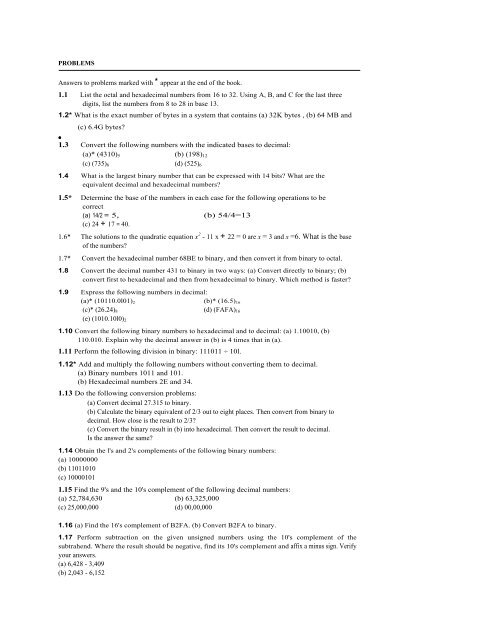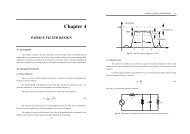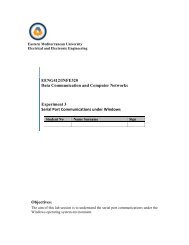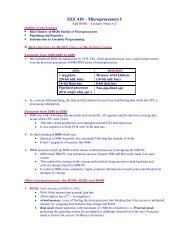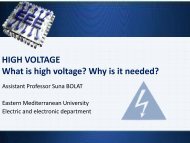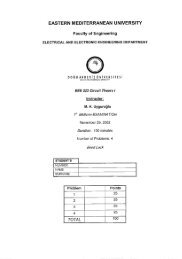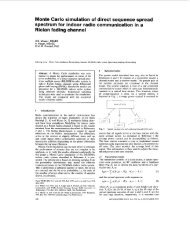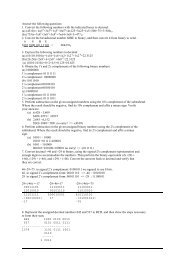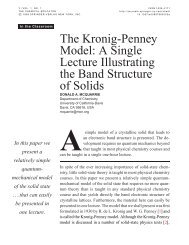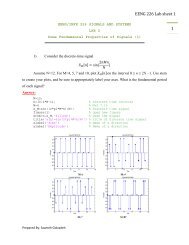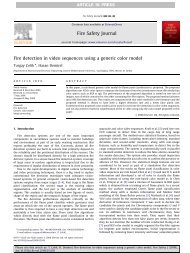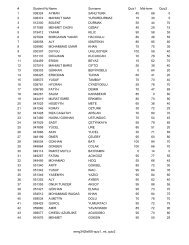Answers to problems marked with * appear at the end of ... - faraday
Answers to problems marked with * appear at the end of ... - faraday
Answers to problems marked with * appear at the end of ... - faraday
Create successful ePaper yourself
Turn your PDF publications into a flip-book with our unique Google optimized e-Paper software.
1.18 Perform subtraction on <strong>the</strong> given unsigned binary numbers using <strong>the</strong> 2'scomplement <strong>of</strong> <strong>the</strong> subtrah<strong>end</strong>. Where <strong>the</strong> result should be neg<strong>at</strong>ive, find its 2'scomplement and affix a minus sign.(a) 10011 - 10001 (b) 100010 - 100011(c) 1001 - 101000 (d) 110000 - 101011.19* The following decimal numbers are shown in sign-magnitude form: +9,286 and +801.Convert <strong>the</strong>m <strong>to</strong> signed-l0's-complement form and perform <strong>the</strong> following oper<strong>at</strong>ions(note th<strong>at</strong> <strong>the</strong> sum is + 10,627 and requires five digits and a sign).(a) (+9,286) + (+801)(b) (-9,286) + (+801)1.20 Convert decimal +46 and +29 <strong>to</strong> binary, using <strong>the</strong> signed-2's-complementrepresent<strong>at</strong>ion and enough digits <strong>to</strong> accommod<strong>at</strong>e <strong>the</strong> numbers. Then perform <strong>the</strong>binary equivalent <strong>of</strong> (+29) + (-49), (-29) + (+49), and (-29) + (-49). Convert <strong>the</strong>answers back <strong>to</strong> decimal and verify th<strong>at</strong> <strong>the</strong>y are correct.1.21 If <strong>the</strong> numbers (+9,742) 10 and (+641) 10 are in signed magnitude form<strong>at</strong>, <strong>the</strong>irsum is (+ 10,383) 10 and requires five digits and a sign. Convert <strong>the</strong> numbers <strong>to</strong>signed-l0's-complement form and find <strong>the</strong> following sums:(a) (+9,742) + (+641)(b) (-9,742) + (+641)1.22 Convert decimal 8,723 <strong>to</strong> both BCD and ASCII codes. For ASCII, an even paritybit is <strong>to</strong> be app<strong>end</strong>ed <strong>at</strong> <strong>the</strong> left.1.23 Represent <strong>the</strong> unsigned decimal numbers 842 and 537 in BCD, and <strong>the</strong>n show<strong>the</strong> steps necessary <strong>to</strong> form <strong>the</strong>ir sum.1.24 Formul<strong>at</strong>e a weighted binary code for <strong>the</strong> decimaldigits, using weights (a)* 6, 3, 1, 11.25 Represent <strong>the</strong> decimal number 5,137 in (a) BCD, (b) excess-3 code, (c) 2421 code,and (d) a 6311 code.1.26 Find <strong>the</strong> 9's complement <strong>of</strong> decimal 5,137 and express it in 2421 code. Show th<strong>at</strong><strong>the</strong> result is <strong>the</strong> l's complement <strong>of</strong> <strong>the</strong> answer <strong>to</strong> (c) in Problem 1.25. Thisdemonstr<strong>at</strong>es th<strong>at</strong> <strong>the</strong> 2421 code is self-complementing.1.27 Assign a binary code in some orderly manner <strong>to</strong> <strong>the</strong> 52 playing cards. Use <strong>the</strong>minimum number <strong>of</strong> bits.1.28 Write <strong>the</strong> expression "G. Boole" in ASCII, using an eight-bit code. Include <strong>the</strong>period and <strong>the</strong> space. Tre<strong>at</strong> <strong>the</strong> leftmost bit <strong>of</strong> each character as a parity bit.Each eight-bit code should have even parity. (George Boole was a 19thcentury m<strong>at</strong>hem<strong>at</strong>ician. Boolean algebra, introduced in <strong>the</strong> next chapter, bearshis name.)1.29* Decode <strong>the</strong> following ASCII code:10000010 1101001 1101100 1101100 1O00111 1100001 1110100 1100101 1110011.1.30 The following is a string <strong>of</strong> ASCII characters whose bit p<strong>at</strong>terns have beenconverted in<strong>to</strong> hexadecimal for compactness; 73 F4 E5 76 E5 4A EF 62 73. Of <strong>the</strong>eight bits in each pair <strong>of</strong> digits, <strong>the</strong> leftmost is a parity bit. The remaining bits are<strong>the</strong> ASCII code.(a) Convert <strong>the</strong> string <strong>to</strong> bit form and decode <strong>the</strong> ASCII.(b) Determine <strong>the</strong> parity used: odd or even.
•1.31* How many printing characters are <strong>the</strong>re in ASCII? How many <strong>of</strong> <strong>the</strong>m are specialcharacters. (not letters or numerals)?1- 32* Wh<strong>at</strong> bit must be complemented <strong>to</strong> change an ASCII letter from capital <strong>to</strong> lowercase and viceversa?1.33* The st<strong>at</strong>e <strong>of</strong> a 12-bit register is 100010010111. Wh<strong>at</strong> is its content if it represents(a) three decimal digits in BCD?(b) three decimal digits in <strong>the</strong> 84-2-1 code?1.34 List <strong>the</strong> ASCII code for <strong>the</strong> 10 decimal digits <strong>with</strong> an odd parity bit in <strong>the</strong> leftmost position1.35 By means <strong>of</strong> a timing diagram similar <strong>to</strong> Fig. 1.5, show <strong>the</strong> signals <strong>of</strong> <strong>the</strong> outputs f and g inFig.P1.35 as functions <strong>of</strong> <strong>the</strong> three inputs a, b, and c. Use all eight possible combin<strong>at</strong>ions <strong>of</strong> a, b,and c.a b cfFigure P1.35g1.36 By means <strong>of</strong> a timing diagram similar <strong>to</strong> Fig. 1.5, show <strong>the</strong> signals <strong>of</strong> <strong>the</strong> outputs f ands g inFig.P1.36 as functions <strong>of</strong> <strong>the</strong> two inputs a and b. Use all four possible combin<strong>at</strong>ions <strong>of</strong> a and b.a bfgFigure P1.36


